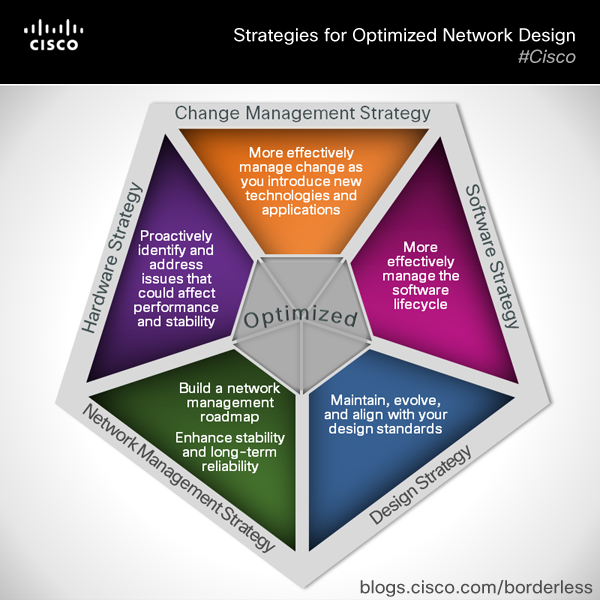































In my last post, I discussed the importance of a strong network foundation. Let's get a little deeper into this now. The strategies depicted in the diagram below have been developed over nearly two decades of Cisco Services experience in the field. These outline what MUST be addressed in order to successfully and fully optimize your investment. Omission of any one will induce risk into the project. I will highlight this as we pass through the strategies.

Design
The design will impact every other strategy and this is why I am starting here. If I only had a nickel for every network that I "fixed" by moving them off of the old administrative VLANs and to a multi-layer or better routed-access campus model, I would be sipping fruity drinks on a tropical island right now. These customers had invested in the correct hardware but had the wrong design and no matter how well we executed the following strategies, success would not be achieved. The VLANs created large fault domains where a problem with any single element impacted all elements. This design was great in its day, there was only data and no need for real-time services. But the time it takes spanning-tree to converge is simply too long for real-time services.
There is no magic single design that works for all customers and all instances. If you are not familiar with Cisco's Design Zone it's important that you visit and bookmark this site. This is where designs that have been proven in the field are documented and posted.
Hardware
Once hardware is deployed, the next step is to ensure that you have a full inventory of the hardware in your network. Once you have this in hand, you can begin to leverage the information that is posted on Cisco.com. Considerations for hardware include:
These hardware considerations can all be a handful to do manually but there are tools to automate tracking end-of-life and field notices. Cisco Prime Infrastructure offers inventory end-of-life and field notice alerting capabilities. Cisco Network Optimization Service (NOS) offers comprehensive reporting and consulting that automates the process of identifying and tracking alerts that could impact your network. More importantly, your NOS engineer will lead in assessing the risk and lead the process to remediate. This service also provides the ability to plug into the stream of Cisco knowledge in real-time. This arms your architecture and engineering teams with the latest best practices from Cisco's ongoing experience in deploying our solutions. As an example, read how Cisco IT worked alongside NOS engineers for design and testing during a major upgrade.
Look for my upcoming post where I will talk about the next step-software strategy.
 Etiquetas calientes:
Cisco Services
Network design
Hardware Optimization
NOS
design zone
five strategies for optimized network design
Etiquetas calientes:
Cisco Services
Network design
Hardware Optimization
NOS
design zone
five strategies for optimized network design